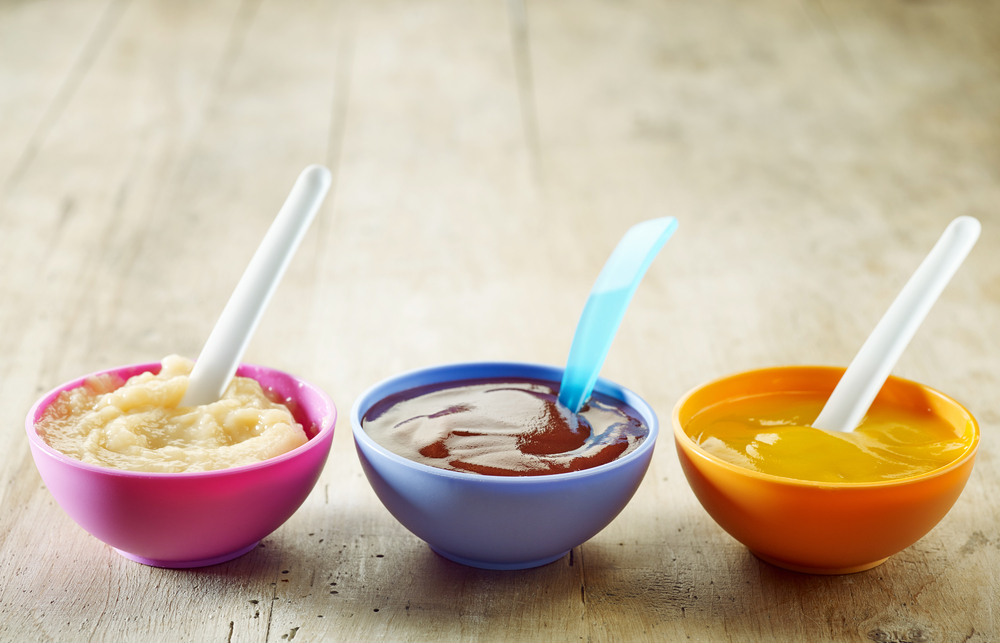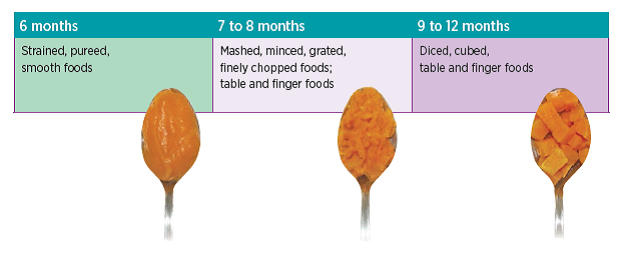Introducing Different Textures of Baby Food

Learning to eat is a skill, just like learning to walk and crawl. Like any new skill, your baby needs a chance to practice. Teach your baby to eat table foods by gradually offering foods with more texture.
Your baby’s first food at 6 months will be pureed. Pureed foods help your baby learn to eat from a spoon and are a good early introduction to feeding. Don’t stop at purees though!
In a few weeks, your baby will be ready for mashed foods. Mashed foods, like mashed potatoes or mashed banana, can be offered with a spoon. This is messy, but it helps your baby learn to feed herself and helps her learn about the texture and feel of food. Learning about her food helps her eat better. Different textures will help her learn to chew, swallow and enjoy the same food as the rest of the family.
Choose foods and textures that are right for your baby’s skill and age. Every baby is different. Your baby may be able to handle different textures at an earlier or later age than the ones in this picture.

Image used with permission from Healthy Child Manitoba
- Offer lumpier foods soon after your baby is used to pureed foods. If you offer them too late, it may be hard for her to get used to lumpier food.
- Babies gag or spit out food when they are learning to eat. This is normal.
- Let your baby explore and make a mess when she is eating. It is part of the learning process. It will help her feel more confident and willing to try new foods.
- Learning to eat takes time. It doesn’t happen overnight.
- Include your baby at the family meal, even if she is still eating pureed food. Eating with the family helps your baby eat better and teaches her about family foods and traditions.
Finger Foods
Around 7 to 8 months, start offering your baby finger foods. Your baby will pick up finger foods with her fingers or hand and put the food in her mouth. Your baby doesn’t need teeth to start eating finger foods. If you can mush it between your fingers, your baby should be able to mush it with their gums. Most older babies enjoy eating with their hands. Be ready for some fun and a mess!
Any soft food can be cut into finger food. Here are some examples:
- Soft, ripe, peeled fruit
- Cut into bite-sized pieces or strips (bananas, pears, peaches, plums, strawberries, blueberries, cantaloupe, kiwi)
- Cut seedless grapes into four bite-sized pieces. They do not need to be peeled.
- Soft, cooked vegetables cut into strips
- Toast strips, bagel pieces, rice cakes, melba toast, unsalted crackers
- Shredded cheese, cheese cubes or sticks
- Cooked tender meat, finely cut up
- Small pieces of boneless, cooked fish
- Cooked macaroni or other pasta
- Cooked eggs, scrambled or hardboiled
- Tofu cubes
- Cooked beans, lentils and peas
Hot parent tips:
- Offer healthy finger foods that are high in nutrients. Avoid foods that have added sugar or salt.
- Finger foods help your baby learn to feed herself and to chew. They are also very important for helping your baby learn to eat the same foods as the rest of the family.
Adapted with permission from Healthy Child MB resource, Feeding Your Baby: 6 months to 1 year
More Information:
- Health Canada – Infant Nutrition
- Free Workshops- Starting Your Baby on Solid Foods
- Follow Dial-a-Dietitian Manitoba on Facebook
Questions?
If you have a nutrition or food question, call Dial-a-Dietitian Manitoba at 204-788-8248 in Winnipeg or 1-877-830-2892. The Dial-a-Dietitian phone number is currently redirected to Health Links-Info Santé. You can leave a message with a nurse and a dietitian will return your call.